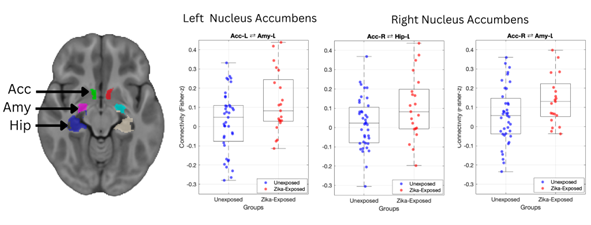Neonatal Neurology 6: Neurodevelopment
Session: Neonatal Neurology 6: Neurodevelopment
676 - Disrupted Ventral Striatal Functional Connectivity in Colombian School-Age Children Exposed In Utero to the Zika Virus
Sunday, April 27, 2025
8:30am - 10:45am HST
Publication Number: 676.4277
Josepheen De Asis-Cruz, Children's National Health System, Washington DC, DC, United States; Sarah B. Mulkey, Children's National Health System, Washington, DC, United States; Kushal Kapse, Children's National Health System, Washington, DC, United States; Regan Andringa-Seed, Children's National Health System, Washington, DC, United States; Margarita Arroyave-Wessel, Children's National Health System, Washington, DC, United States; Madison Berl, Children's National Hospital, Washington, DC, United States; Carlos A. Cure, BIOMELAB SAS, Barranquilla, Atlantico, Colombia; Hironori Teramoto, Children's National Health System, Arlington, VA, United States; Maria G.. Mora Alvarez, Children's National Hospital, Washington, DC, United States; Gilbert Vezina, George Washington University School of Medicine and Health Sciences, Washington, DC, United States; Raul E. Tarud Sabbag, Sabbag Radiologos, Barranquilla, Atlantico, Colombia; Yao Wu, Children's National Hospital, Washington, DC, United States; Catherine Limperopoulos, Children's National Health System, Washington DC, DC, United States
- JC
Josepheen D. Cruz, MD, PhD
Assistant Professor
Children's National
Washington DC, District of Columbia, United States
Presenting Author(s)
Background: The long-term consequences of in utero exposure to Zika virus (ZIKV) even without microcephaly or congenital Zika syndrome (CZS) on brain function are largely unexamined. Our study of children with antenatal ZIKV exposure without CZS reported developmental delays and disrupted mood and behavior, with higher scores on the Difficult Child domain of the Parenting Stress Index at preschool age than non-exposed controls (NEC), suggesting long-term effects on brain development. We posit that functional alterations likely involve the emotional salience network of the brain.
Objective: To investigate ventral striatal (VS) functional connectivity (FC) differences between ZIKV children and NEC in Colombia
Design/Methods: We compared resting state functional connectivity MRI (rs-fMRI) data at age 7 years from 21 ZIKV-children (born to mothers with ZIKV in pregnancy and no CZS) and 39 NEC who were part of a prospective longitudinal study examining the effects of ZIKV on brain development. FMRI data were preprocessed using an age-appropriate pipeline. To estimate FC, we used seed-based correlation analysis using the VS regions, particularly the areas of the nucleus accumbens (Acc) as defined in the Haskins Pediatric Atlas. Connectivity to the contralateral Acc, amygdala (Amy), and hippocampus (Hipp), critical components of the emotional salience network, were examined. FC was estimated by computing the pairwise Fisher-z transformed Pearson correlations across all six regions. Statistical tests were thresholded at p< 0.05.
Results: Children were scanned on average at 2657±65 days (ZIKV: 2595±38, 15 females; NEC: 2642±70, 22 females). We observed increased connectivity between the left Acc to the left Amy (p=0.03), the right Acc to the left Amy (p=0.03), and the right accumbens to the left hippocampus (p=0.04) (Fig 1).
Conclusion(s): Past work has implicated dysregulated nucleus accumbens-amygdala-hippocampus neural circuitry in behavioral difficulties and emotional dysregulation in humans. Notably, these circuits have been linked to increased emotional reactivity and socio-cognitive impairments in ZIKV-exposed non-human primates. Our findings suggest potential neural substrates for the changes in mood and temperament reported in children with in utero ZIKV exposure. Longitudinal neurodevelopmental assessments and MRIs would help understand the trajectory and clarify the long-term implications of this exposure.
Figure 1. Increased connectivity between bilateral nucleus accumbens regions and limbic areas in ZIKV-exposed children.
 The leftmost panel shows regions of interest, abbreviations: Acc: nucleus accumbers area, Amy: amygdala, Hip: hippocampus.
The leftmost panel shows regions of interest, abbreviations: Acc: nucleus accumbers area, Amy: amygdala, Hip: hippocampus.
